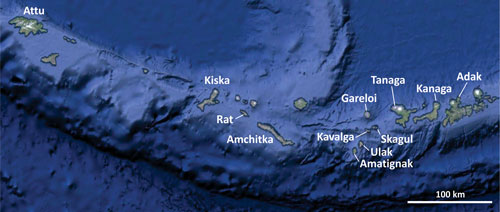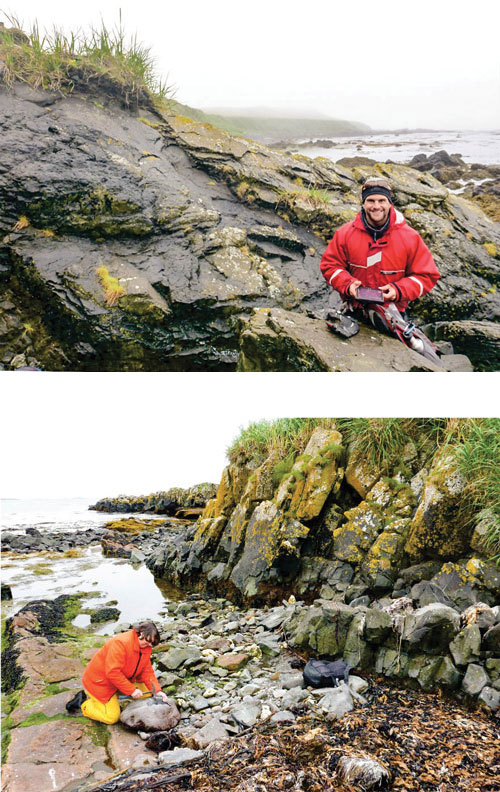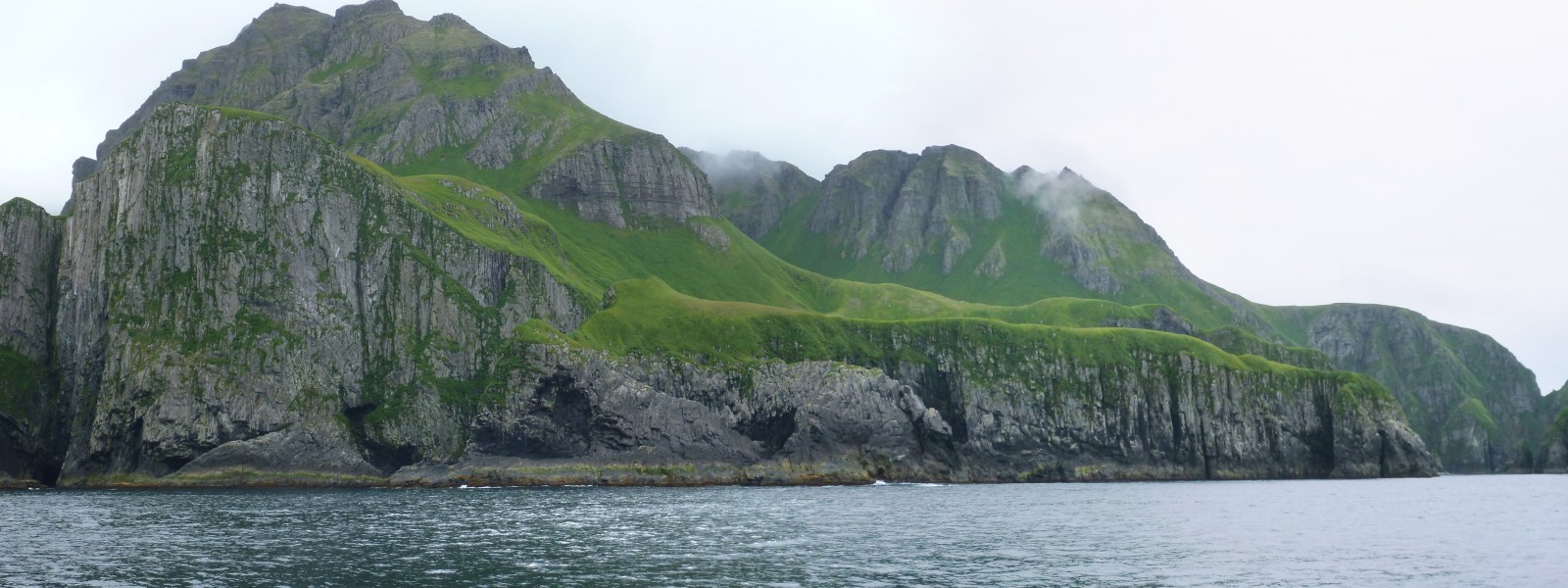Brian Jicha1 and Suzanne Kay2
1Department of Geoscience, University of Wisconsin-Madison, Madison, WI, 2Department of Earth and Atmospheric Sciences, Cornell University, Ithaca, NY

Figure 1. Google Earth image of western Aleutian arc showing islands studied as part of this project.
The Alaska-Aleutian Arc extends for more than 3500 km westward from central Alaska to the Kamchatka Peninsula. The timing of Aleutian Arc inception and subsequent compositional evolution through the initial stages of arc growth are poorly known. Early estimates of Aleutian Arc inception varied from 70 to 40 Ma (e.g., Grow and Atwater, 1970; Scholl et al., 1986), but were based on very little data. Determining precisely how and when the Aleutian Arc began to form was one of the initial goals of this project. By addressing a central question of the GeoPRISMS Program (What are the physical and chemical conditions that control the development of subduction zones, including subduction initiation and the evolution of mature arc systems?) we intended to help link subduction initiation in the Aleutians with similar tectonic events at subduction zones in the western Pacific.
We identified outcrops on several islands that appeared to have a high probability of providing new limits on the timing of arc inception. Specifically, we focused on mafic ‘basement’ rocks and intrusives that cut the mafic lavas on Amatignak, Ulak, and Amchitka Islands (Fig. 1). These islands were interpreted to host remnants of the very early growth of the Aleutian Arc prior to northward arc migration. We also aimed to acquire new samples of the Vega Bay formation on Kiska Island and investigate the Finger Bay Volcanics on Adak Island (Rubenstone, 1984; Kay and Kay, 1994) from the extensive sample suite in the collections at Cornell University.

Figure 2. Allen Schaen (top) and Suzanne Kay (bottom) collecting samples from Rat and Skagul Islands, respectively in 2013.
Two reconnaissance field campaigns were conducted in the summer of 2012 and 2013 with the help of the U.S. Fish and Wildlife service vessel M/V Tiglax. In 2012, we (Jicha and Cornell Ph.D. student Ashley Tibbetts) spent two weeks in the central and western Aleutians sampling lavas from Adak, Kiska, Ulak, Amatignak, and Kagalaska islands. Initial 40Ar/39Ar incremental heating experiments and geochemical analyses revealed that most of the subaerial samples of the older portions of the central and western Aleutians are < 40 Ma and thus provide little information on subduction initiation. As a result, we refocused our priorities and aimed to constrain the along- and across-arc chemical evolution of the central and western Aleutians over the last 40 Myr of arc history (e.g., Kay and Kay, 1994). In August 2013, we (Jicha, Kay, UW-Madison M.S. student Allen Schaen) conducted another sampling campaign with an emphasis on two regions: a SW-NE trending transect from the southern (Amatignak and Ulak) and central (Kavalga, Ogliuga, and Skagul) Delarof Islands to the Pleistocene-Holocene volcanoes on Gareloi and Tanaga Islands, and the Rat Island to Attu island segment of the western Aleutians (Figs. 1, 2). The first transect is the focus of the Master thesis of UW-Madison student Allen Schaen, which aims to compare the temporal evolution of igneous and tectonic processes in the Delarofs with similar studies on the Adak Island to the east (e.g., Kay and Kay, 1994) and the Attu Island to the west (e.g., Yogodzinski et al. 1993). The thesis of Tibbetts focuses on the evolution of the Aleutian basement on the islands of Attu, Kiska and Rat.
Overall, we have conducted 40Ar/39Ar laser incremental heating experiments and major, trace-element, and Sr and Nd isotope analyses on more than 130 samples. A summary of the findings is provided here:
Twenty-two 40Ar/39Ar ages reveal that magmatism in the Delarof region spanned 37 million years and was coincident with two arc-wide magmatic flare ups in the late Eocene/early Oligocene and latest Miocene/Pliocene (e.g., Jicha et al., 2006). A significant transition in arc chemistry of the lavas in this region occurs in the Pleistocene where lavas from nearby volcanoes Gareloi and Tanaga exhibit higher sediment signatures (e.g., Th/La) and lower 143Nd/144Nd compared to older Delarof Islands closer to the trench. Similar findings from Eocene-Miocene lavas within the western Aleutians from Amchitka to Adak suggest that a sediment melt component was unavailable early in the development of the western Aleutian Arc, but has become more pronounced in the Quaternary.
As part of our attempt to understand the evolution of the Central Aleutian arc lower crust we have studied and dated gabbroic composition granulite xenoliths from the Cornell collection of ~200 samples from Kanaga Island. The mafic xenolith suite is composed of plagioclase-clinopyroxene ±orthopyroxene-titanomagnetite-bearing gabbroic xenoliths with rare olivine and adcumulate textures, pyroxene granulites with granoblastic textures, and deformed recrystallized mafic granulites. The variable textures, mineral chemistries and isotopic ratios of these xenoliths show they had experienced a complex history before being incorporated into their ~7 Ma Mg-rich basalt host lava. These mafic xenoliths, along with the ultramafic xenoliths, are interpreted as lower crustal cumulates of basaltic to mafic andesitic arc magmas (e.g., Kay et al., 2013). It is from a mafic two-pyroxene granulite xenolith that we have surprisingly obtained the oldest ages yet reported in the Aleutian arc. This age comes from extremely challenging 40Ar/39Ar incremental heating experiments on low K (~An68Or0.4 Ab31.6) plagioclase, which yield complicated spectra, but give a plateau age of 47.8±4.3 Ma. We interpret this age as a time of metamorphism and recrystallization of mafic arc cumulates by younger arc magmas intruding the existing arc crust.
Calc-alkaline I-type plutons, like those thought to be major crustal building blocks of continental margins are rare in oceanic island arcs, but are present in the pre-Pliocene record of the Aleutian arc (e.g., Kay et al., 1990). The oldest and most calc-alkaline of these is the ~10 km wide Hidden Bay pluton on Adak Island, which intrudes the early Tertiary Finger Bay Formation. Published K-Ar (Citron et al., 1980) and new 40Ar/39Ar and U-Pb zircon ages from 16 gabbro, porphyritic diorite, diorite, granodiorite, leucogranodiorite and aplite units show the pluton evolved from 34.6 to 30.9 Ma in a series of events during a waning magmatic phase. The similarity of chemical analyses of the isotropic gabbros with modern Aleutian high-Al basalts supports minimal evolution of the central Aleutian magmatic source since at least 34 Ma. Mineralogical, trace element, and isotopic evidence suggest the plutonic units largely evolved in the deep crust with final crystallization and segregation of aplites occurring at shallow levels. Overall, the diorites are cumulates, whereas the volumetrically dominant granodiorites (58-63% SiO2) along with the leucogranodiorites (67-70% SiO2) approach melt compositions. The presence of calc-alkaline plutons in the central Aleutian arc by 34 Ma requires stability of pargasitic hornblende, crustal thicknesses approaching those of the modern arc by 34 Ma (~37 km on Adak; Janiszewski et al., 2013), a parental magma similar to that from the present-day arc, and a contractional stress regime. Such a scenario requires a very rapid build-up of the Aleutian ridge in the Eocene.
Building on the model of Yogodzinski et al. (1993), we have also been investigating the early evolution of the western arc. Our new chemical and 40Ar/39Ar analyses show that both the host rock (40.3±0.1 Ma) and the gabbroic units (34.7 to 27.2 Ma) have depleted epsilon Nd values (+9-10.8) and Marianas-like trace element chemistry (e.g., depleted LREEs). These NE-striking units are bordered on the west by 35.6 to 28.8 Ma altered MORB-like pillow lavas, breccias and dikes. Still further west lies a band of MORB-like rhyolite-albite granites with one rhyolite giving a 40Ar/39Ar age of 16.2±0.1 Ma. Thus, our new data indicates the oldest units on Attu formed in a Marianas-like arc between 40 and 16 Ma. To our knowledge, similar magmatic rocks are virtually unknown east of Attu. In contrast, the youngest Attu volcanic rocks form an east-west trending band of 8-6 Ma calc-alkaline andesites with lower eNd (+7.5-9.0) that erupted as calc-alkaline volcanism was occurring all along the arc. Combining this change in the strike of magmatic centers on Attu with published paleomagnetic data from Kiska (Minyuk and Stone, 2009) suggests a ~40-50° clockwise rotation of the western Aleutians along with uplift on Attu after 16 Ma and before 8 Ma.
Our ongoing and future efforts for the samples collected in 2012 and 2013 coupled with the vast collection at Cornell University will be focused on quantifying subduction erosion and subsequent northward migration of the arc with time, and evaluating the evolution of the different parts of the central and western Aleutian arc in comparison to the Attu-Rat, Delarof, and Kanaga-Adak segments.
Reference informationGeoPRISMS Newsletter, Issue No. 34, Spring 2015. Retrieved from http://geoprisms.nineplanetsllc.com

